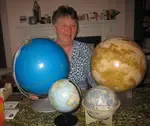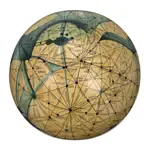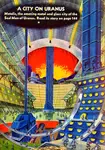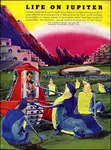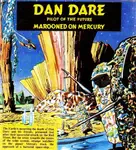lunar surface creatures
[ + links to: The Moon - Ancient Inhabited Moon - Lurkers on the Moon
- Land Rush, King Rush, Moon Rush - The Great Moon Hoax ]
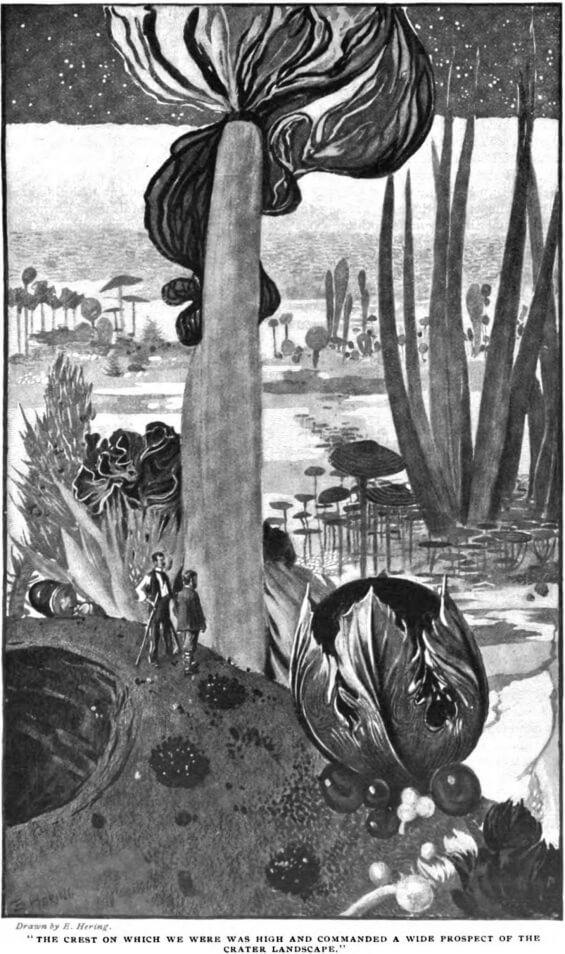
It's possible to feel more powerfully stirred by a glimmer than by a dazzle.
What we're searching for is an elusive vision, a trace-ecology if you will - permitting our neighbouring world some limited smears of life, thin enough not to tarnish its silvery sheen...
Harlei: Sounds like a difficult literary balance! Has it ever been achieved?
Zendexor: I'd say we're still waiting for it. The old phrase "crying for the moon" is still apt, in that sense. Certainly it wasn't rendered out of date in July 1969...
Stid: Nor do I expect the blubbing ever to stop, so long as lachrymose romantics are still around, Zendexor.
Zendexor: That's because those of us who are gifted with refined sensitivity can still weep at the thought of a dead world. Dead in real life and in most of literature too.
Harlei: Ah, come on, Zendexor, you know things aren't that bad. You went all out in the main Moon page to show that our "dead" satellite is very much alive in an inorganic sense with its haunting mystery. And then there's the page for the ancient inhabited Moon...
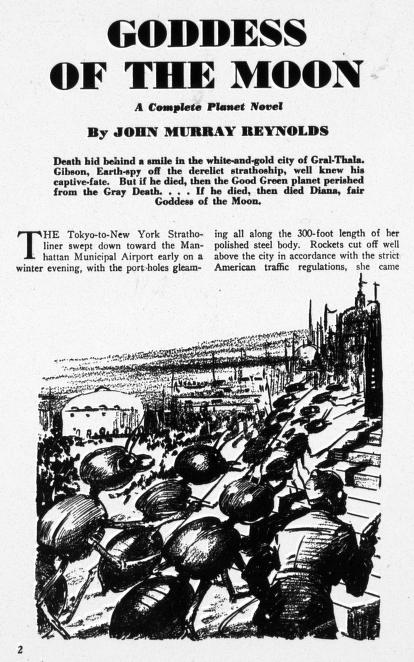
Zendexor: Yes, yes, ancient - but what about the present? And what about native life on the surface? Like, the lunarian insects we can see in the promising picture here...
Stid: Never heard of this tale. Which suggests it can't be that good.
Zendexor: Depends what you want. A story like Goddess of the Moon requires that the reader adjust his expectations...
Stid: Or, in other words, like I said, it's not that good.
Zendexor: Will you stop putting words into my mouth? The trouble with you is, you're so fond of reading between the lines, you forget to read what's on the lines. All my carefully worded nuances thus get overlooked. What I'm actually saying is... oh, heck, Stid, you're right, the story's not that good. But - listen - it has something. It plays a part in getting me to raise my demands. It inspires me to insist upon more, and better, tales of its kind. Tales about native lunar surface life.
Stid: It seems to me, Z, that you're asking rather a lot. Granted that the Old Solar System wallows in colourful improbabilities, it ought to steer clear of blatant contradictions.
Zendexor: Meaning...?
Stid: We're talking about a world whose surface we can actually see with the naked eye. We all know what the Moon looks like. We see its sharp outline, its lifeless silver-grey, its blatant lack of air and vegetation! Any tale about a fertile Moon must place an exceptional strain on even an OSS-genre fan's capacity to suspend disbelief. In short, it can't work.
Harlei: You're forgetting Wells' description -
Stid: Not quite. Admittedly in The First Men in the Moon there is plant life, and some thin air, but the plants die and the air freezes solid during the lunar night. The ecology is somewhat tenuous, and very pale, so as to be plausibly invisible to telescopic observers on Earth. Wells just about gets away with it, but he wouldn't have if he'd tried to set the main part of the plot on the lunar surface. Most of the action and the discoveries take place underground. And you're always going to get that downward pull, to caves and caverns and (in The Moon Maid) to an entire hollowed-out Lunar Pellucidar, as authors strive to evade the impossible task of portraying convincing lunar surface life.
fighting the downward pull
You'll see it in story after story. Even if the little world does possess some lingering vitality, you can almost always bet that the life is what you might call marginal, spatially or chronologically, or both. The Lunar Pit is typical of the sort of tale in which you get but a glancing reference to a past when the surface was inhabited:
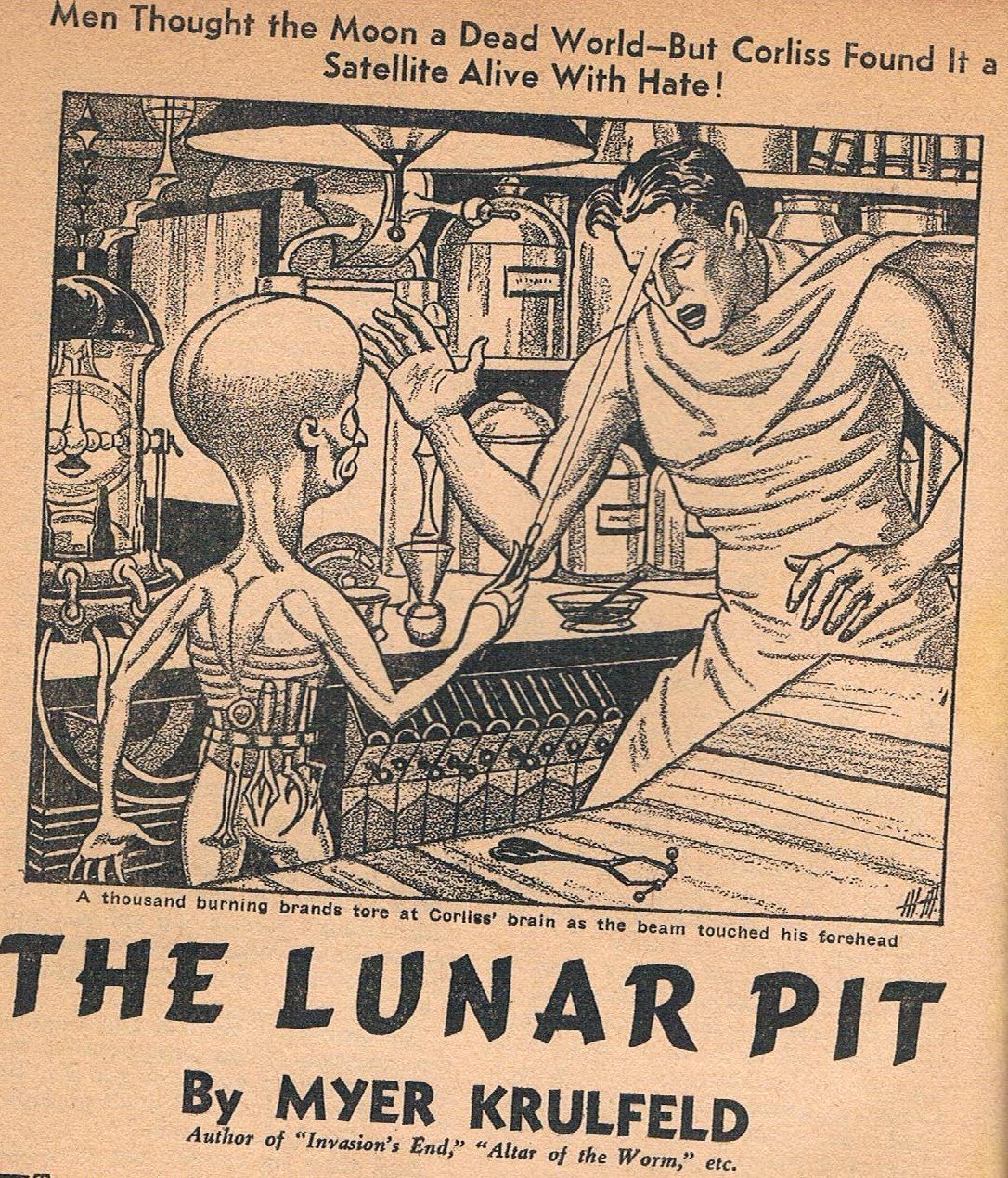
"...Li-Kar was built aeons ago, when my people realized that in a comparatively short time the Moon would lose its air. They dug a chasm almost five hundred miles deep on the side of the Moon away from the Earth, where the Earth's gravitational pull would reinforce that of the Moon, even if slightly. The stronger pull sucked most of the remaining air on the Moon into the pit, preventing its escape - as it would have from the weaker gravitational grip at the surface..."
Quite clever, to dig a chasm hundreds of miles deep. Pity they weren't a bit cleverer so as to create a force-field to retain the atmosphere on the surface, and thus continue to live in the open - because you'd have liked these Lunarians, Zendexor. They were real natives, not mere COMOLDy relatives of ours.
Three days passed, days of wonder, of old mysteries solved, of a new world and new people - days during which Corliss was filled sometimes with admiration, sometimes with disgust and hatred, but always with the consciousness of the flying seconds.
He visited the laboratories and the power receiving and transforming stations. He went through the crowded levels of the dwellers. He saw a slow dance performed before a packed theater crowd by a serpentine Moon-woman, utterly ugly to his human standards, yet with an unearthly beauty of her own. He listened to sad, cold music, like the complaint of proud demons...
Zendexor: This is supposed to be a page about lunar surface creatures, but I let you go on about this underground story, Stid, partly to demonstrate the challenge we're facing. Just about the entire corpus of literary material which we might have cited can only be brought into line, as it were, by wrenching the evidence. Thus, that "serpentine Moon woman" might have had an ancestor who looked like her, and who lived out in the open.
Now let's get back to Goddess of the Moon, which does at least provide us (some of the time) with an adventure on the lunar surface.
neglected insect-men
This particular crater was a small one, and the level floor was only some thirty yards below the rim. Larry stared in amazement at the creatures which were coming to sit in long rows around a small mound in the center of the crater. He hardly knew whether to call them men or animals. They had the hard shell and articulated legs of an insect, but their faces had a semi-human appearance in spite of the pair of long antennae that grew out of their foreheads...
...Some of the insect-men came out of small, dome-shaped mounds that might have been houses. Others came climbing down the far side of the crater. Their glowing antennae bobbed in ceaseless motion, and there was a constant dry clicking. Suddenly Larry realized that the creatures were talking together!
That meant that there was at least some atmosphere on the Moon! Enough to carry sound!
Some, but not much, air. This theme is developed a bit further in the story. We have what we might call a scrappy-tinctured Moon: a world whose biosphere is not a lush blanket like Earth's, but marginal and rudimentary. The outside doesn't kill humans immediately; it can be nakedly endured for a few minutes if the right preparations are made, as Diana (a descendant of Terran castaways who has become a "goddess" to "the sluggish minds of the insect-men") explains:
"...I am wondering how you managed to survive up there on the surface where there is little or no air and it is always so cold."
"I could not stay very long." From a fold in her loin cloth the girl drew out a tightly closed glass bottle that held some white tablets. "These contain oxygen mixed with some gases unknown on Earth, the whole very strongly compressed into solid form. Ten minutes after I have swallowed one, it is safe for me to go out on the surface. The effect lasts for about fifteen minutes..."
This sort of gesture-science is exactly what a life-on-the-Moon tale needs to make it work: what we want is an adequate nod in the direction of superficial plausibility, ignoring some problems (notably lack of air-pressure) and dealing perfunctorily with others (e.g. the need for oxygen intake of some sort). I'm fond of gesture-science -
Stid: We know, Zendexor. It has been noticed.
Zendexor: - but after such a promising beginning, Goddess of the Moon disappointed me, because the author turned his attention away from the native lunar insect-men. Nevertheless the story is worth studying for its interest in the margins of habitability; for the idea that some parts of the moon are less harsh than others; for its basic inspiration, that the most promising and exciting kind of Lunarian tale needs to be set on - I shall christen it now - the MHM: the Marginally Habitable Moon.
The temperature rose rapidly … and before long the frost on the space suits was melting. Then, stretching along the crest of a mighty mountain range ahead, Larry saw a lofty gray wall that went so high its top was almost lost from view above. They had come within sight of the Great Barrier!
Several times along the way they had been halted by sentry-patrols from some of the other outlaw caverns, who warned them that an unusual number of strong parties of troops from Gral-Thala were roaming the wasteland.
- Goddess of the Moon
"Roaming the wasteland," you see! Think of the connotations of that phrase: an area contrasting with contiguous fertile lands. And sure enough:
The tunnel ended on the inner slope of the mountain range surrounding Gral-Thala, where many cars ran down the steep incline into the valley below. It was a pleasant and smiling land that Larry Gibson saw before him, a sunlit and fertile valley so vast that even the lofty range on the far side was invisible over the horizon. Towns and villages dotted the plain. Farms lay among their fertile fields. A small river wound through the center. Directly below him, clustered against this part of the valley wall, was a mighty city.
"This is the city of Pandonaria," Diana's voice came softly through her veil, "capital city of Gral-Thala."
The city itself was a terraced mass of colored buildings cut by many streets and interspersed with gardens. Several towering palaces of white and gold, the abodes of the Lords of Gral-Thala, dominated the lower buildings. It was good to see real sunlight again! To see birds flying overhead! To smell the odor of flowers and growing things, in contrast to the flat and motionless air of the Lost Caverns! It was hard to believe that this pleasant spot was really the scene of such a brutal tyranny as he had been told...
Wow - birds flying in the sunlight on the Moon!! It's such a great idea to postulate a habitable surface of the low-altitude air-bowl variety...
A pity that the inhabitants are descended from Earthlings - as is explained earlier in the story:
"...The simple-minded but husky Insect-men were the original inhabitants of the Moon. Long aeons ago, while most of the people of Earth were living in caves and using chipped stones for tools and weapons, an isolated people developed a high civilization in what I have roughly identified as the region of the Himalayas. A series of great earthquakes destroyed their civilization, but a large number of them escaped and came to the Moon in some kind of a space-ship. Here they found, in those days, a small planetary body that had a thin but breathable air. They founded a civilization on the other side of the Moon where it is always sunny [sic], and called it Gral-Thala. Those were pleasant days, if the old legends are to be believed, the Golden Age of Lunarian civilization...
"As the centuries passed, the atmosphere continued to thin... so the Ancients took care to preserve what was left. Gral-Thala is in the fertile part of the Moon, and lies in a vast valley completely surrounded by a lofty mountain range. By means of the superior engineering knowledge of the Ancients, they built a lofty wall or barrier along the crest of the range so that its top is miles above the level of the valley floor. They then sucked all the air within the Great Barrier. Gral-Thala itself thus lies in a great pool of air surrounded by the ranges and the barrier. On the rest of the Moon... air only remains in deep crevices and caverns..."
I want to say, never mind these sordid power-struggles between folk of Terran descent, I want real Lunarians - yet sad to say, the genuine natives are allotted only minor parts in the drama of Goddess of the Moon.
successful and clever lunarians
One version of our neighbouring world which doesn't allow too many Terrans to hog the limelight is Dr Dolittle in the Moon...
Harlei: I'm uneasy about including that one, Zendexor: not because it's a children's book, but because, I don't know, it's somehow... maybe... not, er, mooney enough...
Zendexor: Not enough gesture-science, is what you're doubtless trying to say. I partly agree. Mind you, I wouldn't throw it out of the corpus of Moon-literature as readily as I would dismiss any pretension on the part of The Worm Ouroborous to be included in the literature of Mercury. The Eddison Mercury even has a moon of its own! And no nod at Mercury except for the name; not even a larger Sun in the sky. Whereas, Dr Dolittle's Moon does at least have low gravity and slightly thinner air. Nevertheless the story does edge rather far from the mainstream personality gestalt of the OSS Moon, in its admittedly interesting way.
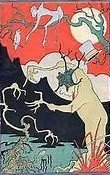
The woods grew more and more mysterious, and more and more alive, as we went onward towards the other side of the Moon, the side that earthly Man had never seen before. For one thing, the strange music seemed to increase; and for another, there was more movement in the limbs of the trees. Great branches that looked like arms, bunches of small twigs that could have been hands, swung and moved and clawed the air in the most uncanny fashion. And always that steady wind went on blowing, even, regular and smooth.
All of the forest was not gloomy, however. Much of it was unbelievably beautiful. Acres of woods there were which presented nothing but a gigantic sea of coloured blossoms, colours that seemed like something out of a dream, indescribable, yet clear in one's memory as a definite picture of something seen...
Dr Dolittle, having spent his career so far in learning the languages of Earth's animal species, finds that on the Moon he has to learn the speech of the dominant kingdom there, that of plants... Among its intriguing chapter-headings are "The Singing Trees", "The Study of Plant Languages" and "The Land of Colours and Perfumes". In its eeriness the idea can actually seem quite moonlike in a sense... but there's another problem. When you get down to it, it's not only the air or the lush vegetation that I find too incongruous.
Stid: Really? If you can take all that...
Zendexor: It's the fact that the Moon, according to that book, originally split off the Earth. That's what puts me off the most.
Stid: Ah, of course. The talking veg is all right, but not the lunar origin theory...
Zendexor: Aetiologically speaking, I'm a bit of a planetary snob, I admit. I like worlds to have their own accretion pedigree.
Harlei: Can we get away from all that, please? Let's sum up our list of demands. What we want, in our gesture-science mainstream, is a Moon which originally accreted together with, but separately from, the Earth, a Moon which moreover is marginally habitable, so as to be marginally believable, and on the surface of which has evolved a native ecology with Lunarians who possess some sort of culture and possess an intelligence at least equal to ours.
Zendexor: Well done for having so excellently drawn up that statute which the cosmic parliament ought to enact as soon as possible. As a matter of fact I actually know of a tale that approaches the fulfilment of these criteria, at any rate as regards intelligent lunar natives. It is, in my view, one of the most remarkable Moon stories yet written. But - there's always a but, it seems - it has a peculiar problem.
The whole affair was preposterous and infuriating. The first men to land on the Moon knew that it was a dead world. The astronomers had been saying so for a hundred years and the first and second expeditions to reach Luna from Earth found nothing to contradict the theory.
But a man from the third expedition saw something moving among the upflung rocks of the Moon's landscape and he shot it...
Keyhole's version of the Moon confronts us abruptly with the apparently impossible. It does not grant the reader any suggestive gradations of marginal habitability to blur the shock of finding lunar life-forms. The creatures are simply plonked into a scenario which in all other respects is quite realistically desolate.
....The dead body of the first living creature killed on the Moon was carried back to Earth and biologists grew indignant. Even with a specimen to dissect and study they were inclined to insist that there simply wasn't any such creature. So the fourth and fifth and sixth Lunar Expeditions hunted... for further specimens for the advancement of science.
The sixth expedition lost two men whose space-suits were punctured by what seemed to be weapons while they were hunting. The seventh expedition was wiped out to the last man...
After a lot of stupid wasteful murders on both sides, a Moon-creature is captured alive, is studied... and we're treated to a powerful story about contact between intelligent species. But the problem is the skimpy setting. We're not shown any other aspects of the lunar ecology, and this lack leaves the creatures' sophistication oddly juxtaposed with their utterly barren environment. What we really want - like children banging our spoons on the table let's repeat "We want!" - is for an author to give us the whole works: intelligent natives outfitted with a culture and an ecology.
That's why, on this page, I've given more space to the lesser tale. As thought-provoking science fiction Keyhole stands head and shoulders above Goddess of the Moon, and yet the latter provides the more alluring glimmer of a selenographic ideal, the MHM rockscape's ghostly smear, a marginally habitable Luna.
Edgar Rice Burroughs, The Moon Maid (1922); E R Eddison, The Worm Ouroboros (1922); Myer Krukfeld, "The Lunar Pit" (Thrilling Wonder Stories, June 1940); Murray Leinster, "Keyhole" (Thrilling Wonder Stories, December 1951); Hugh Lofting, Dr Dolittle in the Moon (1929); John Murray Reynolds, "Goddess of the Moon" (Planet Stories, Spring 1940)
For the ideas of observer William H Pickering see the Gazetteer entry under Eratosthenes.
For the metal-eating "Moon Dogs" of Edmond Hamilton's Outlaws of the Moon see the extract, Captain Future explores the far side of the Moon.
>> The Moon >> Ancient Inhabited Moon >> Lurkers on the Moon
>> Land Rush, King Rush, Moon Rush >> The Great Moon Hoax


